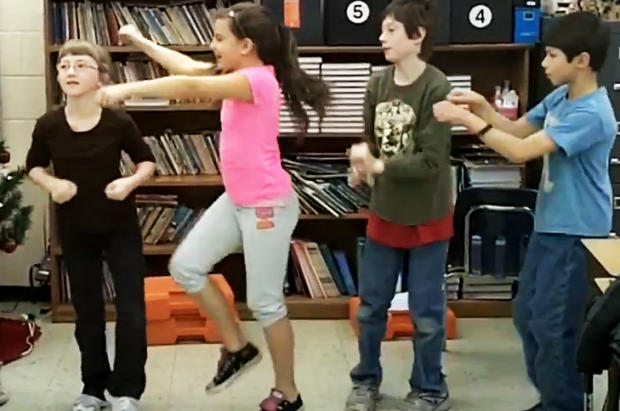The first step was to turn a dance routine into a number pattern. Students logged onto the Pillsbury Dough Boy website and watched, studied and deconstructed the cartoon mascot's six dance moves. They assigned each step a number, and charted the patterns in his dance.
"Once they translated the number to a movement, they began to see how it would be really easy to get a pattern," Lewis said. "I had them watch 'America's Best Dance Crew' so they could see that they're just doing the same thing over and over again."
MAKING THEIR OWN MOVES
The students then choreographed their own dance routines. The teachers required that each routine contain at least five moves that repeated at least once. Songs were to be set to instrumental music of the students' choice -- some opted for hip-hop; others for the Mario Bros theme.
Using stopwatches to clock the average time of their routine, students were asked to then calculate how many times their pattern would repeat throughout the course of the song, and then turn the resulting data into a graph.
"If your song is 100 seconds, how many repetitions will you do of your dance?," Steele said. "If you use the extended version of your dance, 200 seconds, how many repetitions do you need to do? They are using their graph to figure that information out."
ANALYZING THE DANCE
Finally, each group performed their original routine for their classmates. And midway through the dance, they'd freeze, and the class would be asked to predict the next move in the pattern. (Lewis called these "jump-ins.")
In addition to patterns and graphing, the dance lesson helps students with averaging and calculating elapsed time, along with multiplication and division.
"If their pattern was seven [steps] long and they were asked what jump-in 23 was, rather than sit there and count, count, count, they realized they could do multiples," Lewis said. "You could almost see that light bulb go on."
"Dance by numbers" received enthusiastic feedback from a regional conference for STEM teachers, said Arlene Vinion-Dubiel at Sweet Briar College, who helped the teachers implement their lesson plan.
And inside the classroom, results were tangible. Math test scores went up. Shy students happily break-danced at the front of the class. One group performed their routine for the school talent show last year.
"They were 100% into it," Steele said, who expected the boys in her rural classes wouldn't dance in front of their peers.
"Math is such a challenge," Lewis added. "What you're trying to teach them is that what they're learning isn't isolated to a work sheet. That's what STEM is all about -- letting the measurements or the math speak to you and letting it teach you something."
Watch the students in action here:
Via PBS NewsHour.


